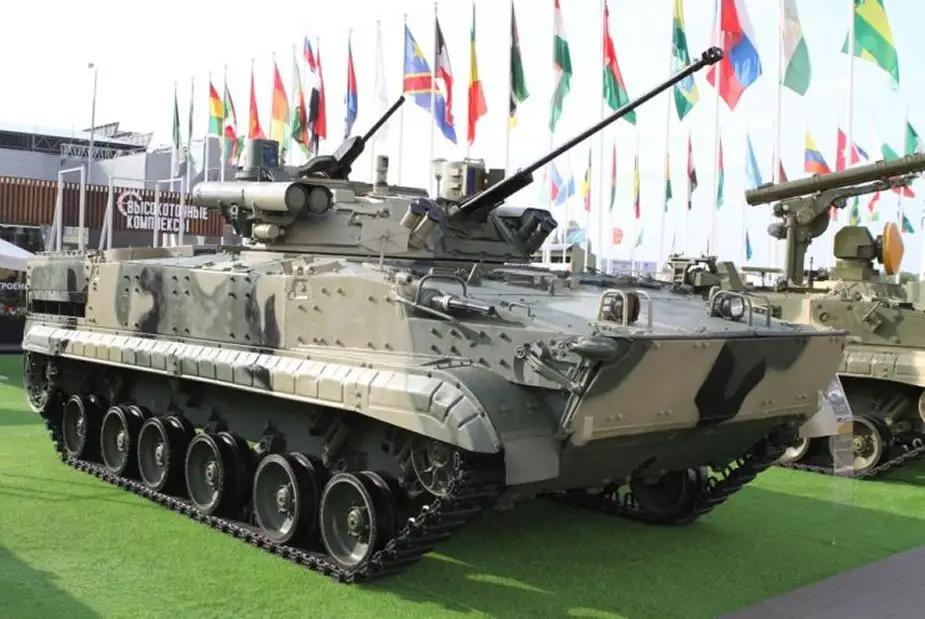Breaking news
Russia introduces Prometheus system to turn military vehicles into remotely controlled robots.
According to an article published by TASS on July 13, 2023, Rostec, a state corporation in Russia, has introduced the Prometheus software and hardware system. This system is designed to transform different types of military vehicles into remotely controlled robotic units. Bekhan Ozdoev, the industrial director of Rostec's weapons, ammunition, and special chemicals cluster, provided detailed information about the capabilities of the Prometheus complex in an interview with TASS.
Follow Army Recognition on Google News at this link

The BMP-3 could be a base for the Prometheus software (Picture source Wikimedia)
Ozdoev explained that the Sinitsa combat module, developed by the All-Russian Research Institute Signal under Rostec, has effectively demonstrated remote control of equipment. Building on this achievement, Rostec has developed the Prometheus software and hardware complex, which can be integrated into wheeled or tracked vehicles like infantry fighting vehicles, armored personnel carriers, or tanks. The conversion process requires minimal modifications while keeping the regular crew positions intact.
The ongoing project aims to enhance the autonomy of these vehicles. With the Prometheus system, the combat vehicles will be able to autonomously follow predetermined coordinates without the need for operator intervention. They will also possess the ability to independently assess the best routes, overcome obstacles, and process information rapidly using technical vision. Ozdoev mentioned that when combined with advanced fire control systems, the Prometheus complex can provide enhanced capabilities.
One example of these Prometheus-equipped vehicles could be the BMP-3 Sinitsa.
The BMP-3 robotic infantry fighting vehicle, featuring the Sinitsa module, was jointly developed by Kurganmashzavod, a subsidiary of the High-Precision Systems holding, and the Signal All-Russian Research Institute. Its initial public demonstration took place on August 16, 2022, at the International Military-Technical Forum Army-2022.
By incorporating specialized equipment, the functions of the driver and gunner have been successfully automated while still allowing for manual control when necessary.
According to a publication released by Rostec at the time, the vehicle operates without a crew, as the driver and gunner functions are robotic. It can also be controlled remotely using a wearable remote control or a remote control point. The vehicle's features enable it to be utilized in the most hazardous areas. For example, it can engage in combat in complex urban environments, lead a battle formation, or provide fire support to motorized rifle units.
The "Sinitsa" combat module differs from the conventional turret of the BMP-3 infantry fighting vehicle due to the presence of a panoramic sight with a thermal imaging channel. This allows for increased range in detecting and identifying enemies and engaging them with firepower.
With armament that includes a 100 mm cannon, a 30 mm cannon, and three 7.62 mm machine guns, the BMP-3 is well-equipped for combat situations. Its advanced fire control system and night vision capabilities ensure precise targeting, even in low-light conditions. Additionally, the vehicle is equipped with an NBC (nuclear, biological, chemical) protection system.
The welded aluminum alloy construction of the BMP-3 provides effective protection against small arms calibers and shell fragments, thereby enhancing the safety of its occupants. Weighing 18,700 kg, this armored vehicle offers a balance between mobility and defense.
The mobility of the BMP-3 allows it to reach speeds of up to 70 km/h on the road, while its amphibious capability enables it to move at 10 km/h in water, providing flexibility in various operational environments. This versatility is a key advantage, allowing for rapid deployment and excellent maneuverability on different terrains.
Capable of accommodating a crew of three and up to seven infantry soldiers, the BMP-3 can swiftly and efficiently transport troops to the battlefield. Its dimensions, with a length of 7.14 m, a width of 3.23 m, and a height of 2.65 m, ensure a compact yet spacious interior that can adapt to various mission requirements. With a range of 600 km, the BMP-3 demonstrates its endurance and ability to operate effectively over long distances, allowing for extended missions without frequent refueling.























